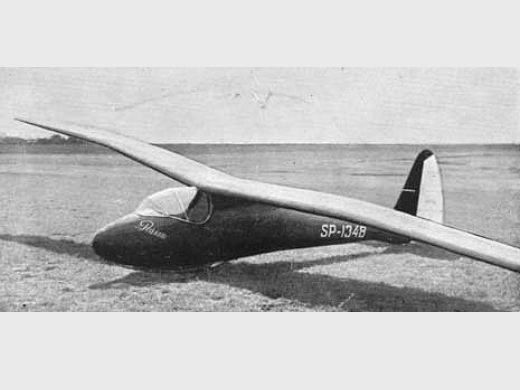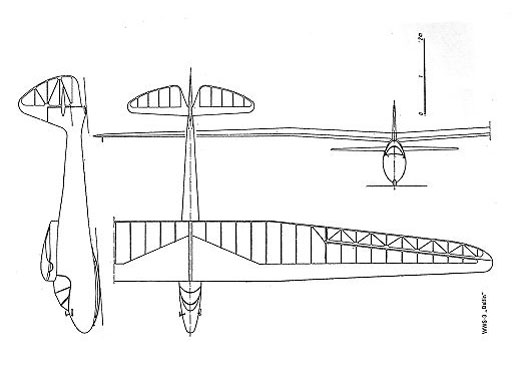
Czerwiński WWS-3 Delfin
| DONNÉES GÉNÉRALES |
| Année du premier vol (ou de design, si seul projet) |
1937 |
| Pays | Pologne |
| Designer(s) | CZERWIŃSKI, Wacław |
| Premier constructeur | Wojskowych Warsztatów Szybowcowych, Krakow, (PL) |
| Type d'appareil | Planeur |
| Fonction | Entraînement |
| SPÉCIFICATIONS TECHNIQUES |
| Envergure | 16 m |
| Longueur | 6.97 m |
| Hauteur | 1.7 m |
| Allongement | 12.7 |
| Surface alaire | 20.15 m2 |
| Profil aile | -- |
| Masse à vide | 135 kg |
| Masse maxi | 232 kg |
| Charge alaire | 11 kg/m2 |
| Vitesse mini | -- |
| Vitesse maxi | 200 km/h |
| Finesse maxi | 21.4 à 52 km/h |
| Taux de chute mini | 0.61 m/s à 45 km/h |
| Nb sièges | 1 |
| Structure | Bois et toile |
AUTRES INFORMATIONS
| Constructeur(s) |
| ||||||||
| Infos techniques | Designed as an intermediate performance glider in which students and pilots could attain their then "D" badge (now known as today's Silver C), the Delfin was the successor to another Czerwiński design, the highly successful Salamandra, and proved to have pleasant flying characteristics. With a cantilever gull-wing and plywood skinned D-box, diagonal secondary spars helped to take up the twisting loads of the wing structure. The fuselage was constructed as a semi-monocoque shell with integral fin carrying the rudder and all-flying tailplane, whilst a pneumatically-sprung nose skid formed the undercarriage. | ||||||||
| Histoire résumée | The W.W.S.3 Delfin was amongst the most successful Polish gliders of the 1930s. Designed by brilliant Polish engineer, Wacław Czerwiński, Czerwiński was at the time head of the W.W.S. (Wojskowe Warsztaty Szybowcowe (military glider workshop). The result of exhaustive wind-tunnel testing at the Lwów Technical University, construction and first flight of the prototype took place in 1936, with further development of the type taking place at the I.B.T.L. ( Instytut Badań Technicznych Lotnictwa- Institute of Aviation Technical Research) in the summer of 1937. The Delfin proved to be popular with students and quickly found success with the then thriving Polish flight schools, notably Ustjanowa Dolna and Bezmiechowa. By the outbreak of war, around a total of 70 Delfin's had been built, with pproximately 40 coming out of Wojskowych Warsztatów Szybowcowych in Krakow, (a military glider workshop in Krakow) and a further 30 at the L.W.L. workshops in Lwów, then a pre-war Polish city. (Bezmiechowa was then a satellite gliding school to the university of Lwów). | ||||||||
| Liens personnalités | CZERWIŃSKI, Wacław (Pologne) | ||||||||
| Exemplaires existants |
| ||||||||
| Compléments docs |
SOURCES DOCUMENTAIRES
| Liens WEB | Site : Site de Piotr Piechowski . Note + 7 photos + plan 3 vues + specs. (2009-11-01 CL) |
| Livres | Bezmiechowa par NATER, Ryszard & GLASS, Andrzej & OLEJKO, Andrzej (2003) []. Polskie konstrukcje lotnicze, Tom III par GLASS, Andrzej (2008) [p. 250-252. Texte + 5 photos + plan 3-vues + specs]. Szybowce Wyczynowe Czerwińskiego par GLASS, Andrzej (2017) [p. 59-76. Texte + 28 photos + plan 3 vues + specs]. Vieilles Plumes n° 11 - Les sports aériens 1941-1944 (3e partie) par COURRIER, Pierre & MARCEAU, Jacques (2000) [p. 139. Texte + plan 3 vues + specs (pas de photo)]. |
| Autres sources | The Delfin, par Ove B. Hillersborg, VGC News n° 137, printemps 2013, p 38-39. Histoire et restauration du OY-DYX. Texte + photos. |

Team J2mcL © 2003 -
- Pages optimisées pour Mozilla Firefox


